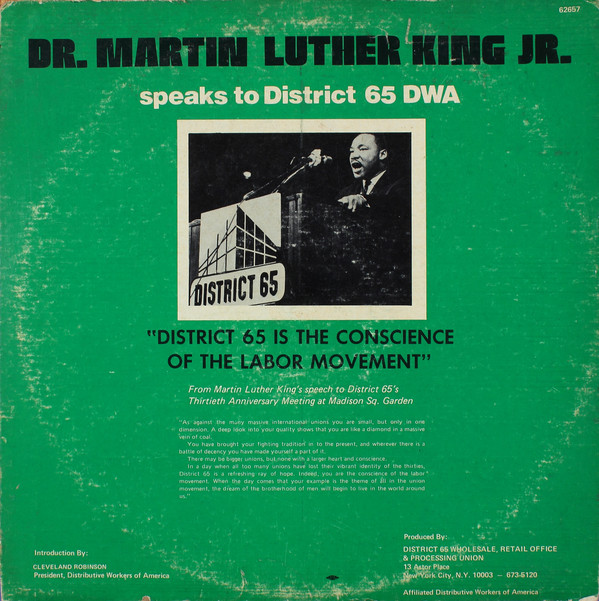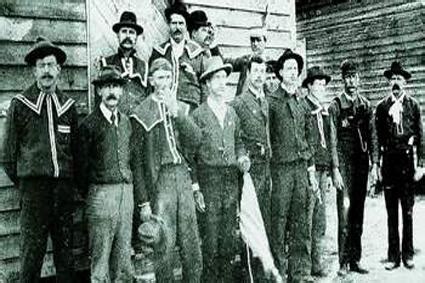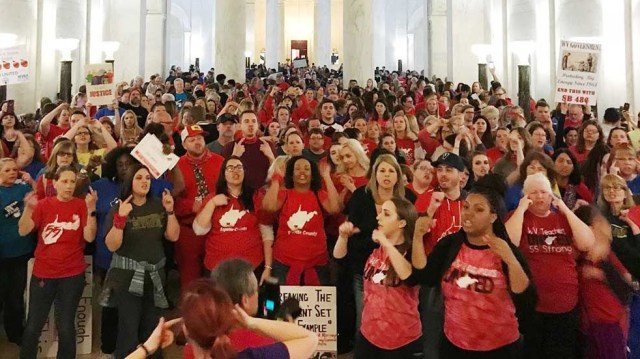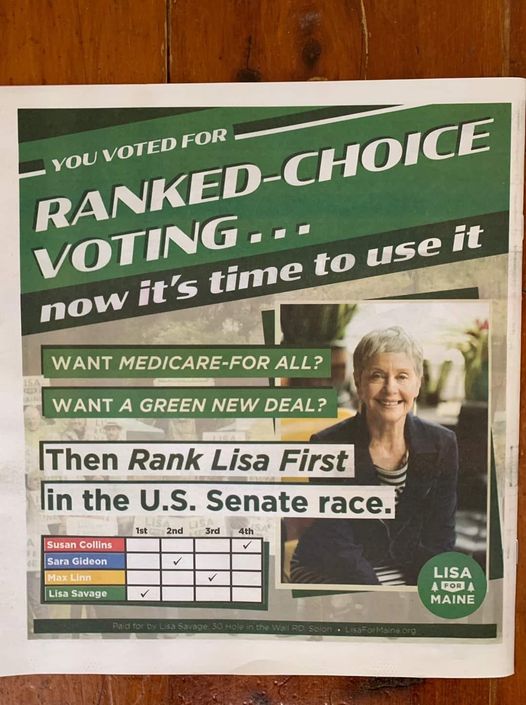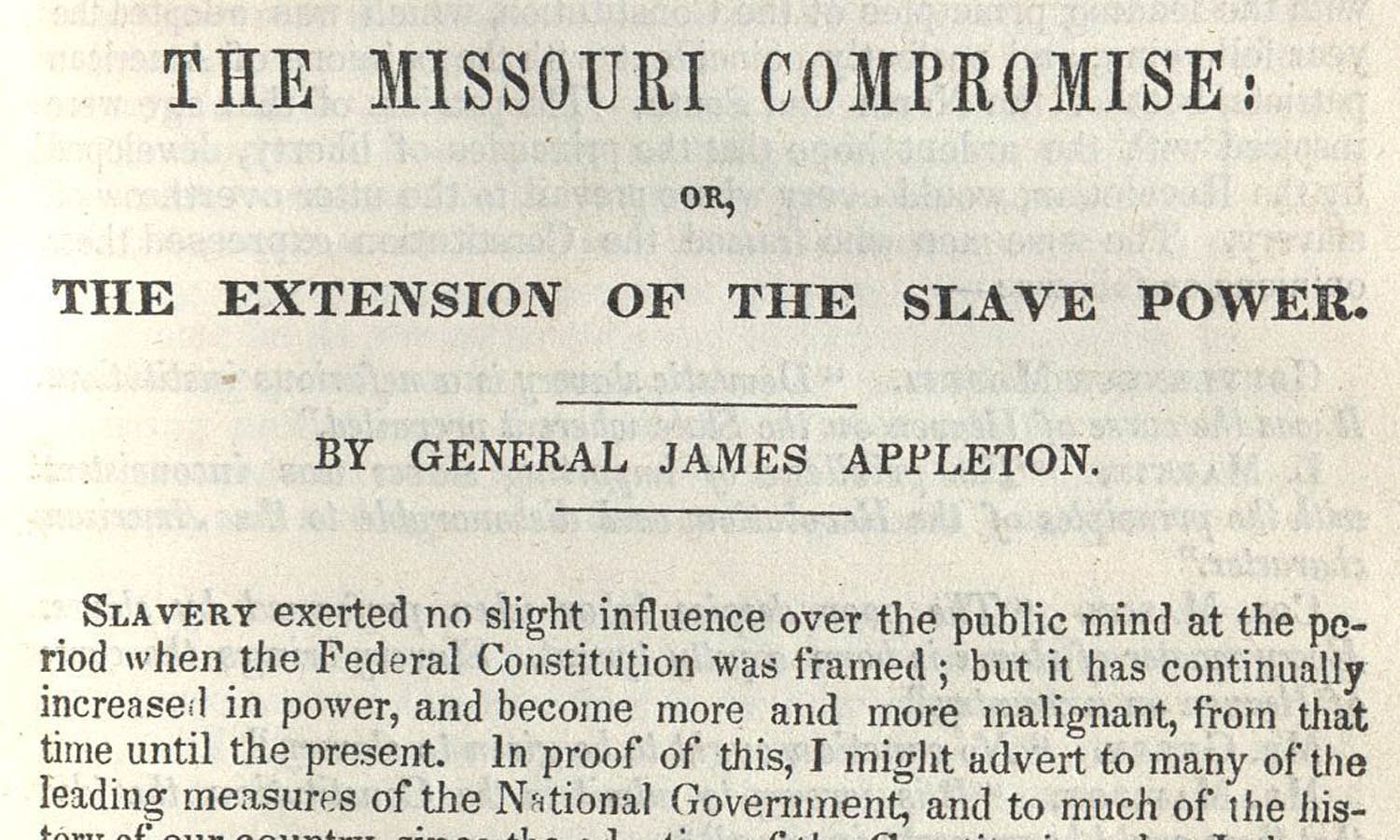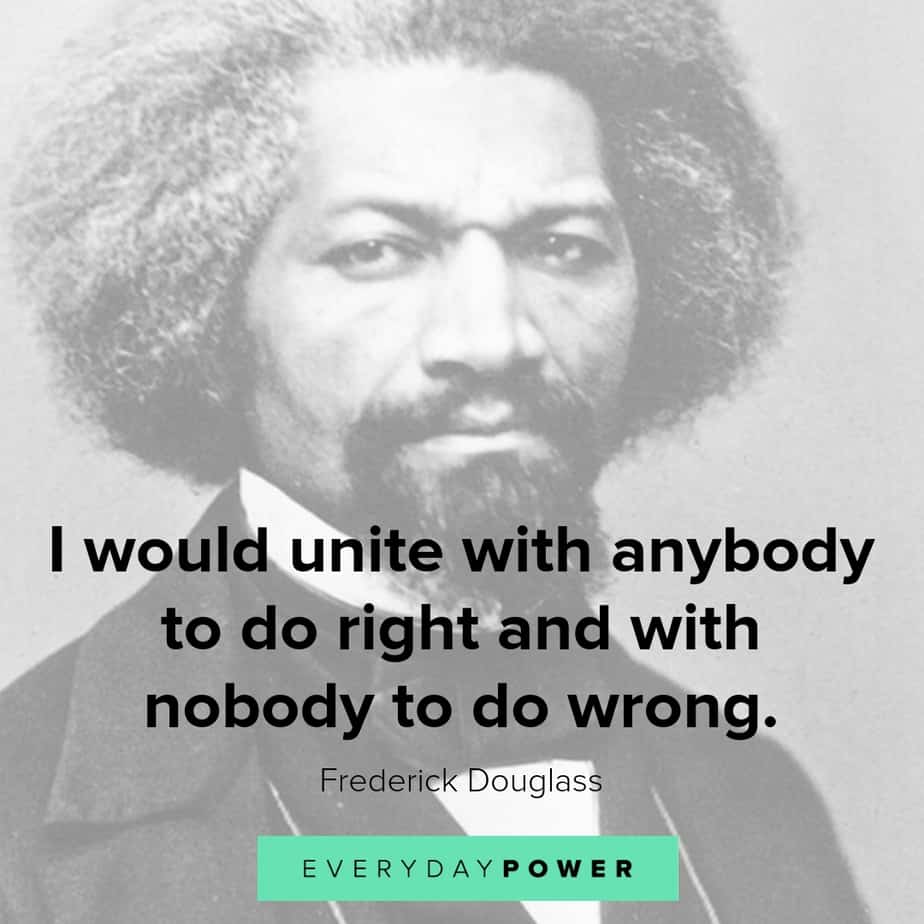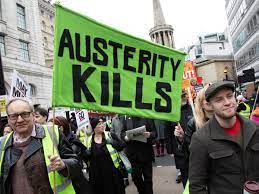
The modern system of austerity took shape in the mid-1970s and we are still in its grip. Austerity is meant to trap us in a destructive double-bind; the race to the bottom for millions of people is also the race to the top for the few. The cost? More than $50 trillion. The human cost in misery, death, and despair? Devastating yet uncounted.
The deliberate creation of poverty and scarcity was necessary for the corporations to consolidate their power. It did not just happen on its own. Austerity required far-reaching structural changes in the US economy.
Beginning in the 1970s the reforms of the New Deal and Great Society were gradually gutted and the economy was recast to suit corporate demands. Biden’s corporate-centered, temporary, and incremental approach won’t touch austerity. Biden promises a small fraction of what is needed and will not reverse the wage cuts at the core of austerity. The major parties will not reform the corporate system that enforced austerity in the first place — instead, they aim to defend it.
Austerity is the big lie: “We Are Broke.” When the big truth is: the economy is rigged and inequality is the result.[1] Austerity is when the ruling class gets most of everything society produces leaving the people with less than they can live on. To bridge that gap, the bosses and bankers substitute high-interest consumer debt for decent wages.
Austerity is the opposite of economic democracy — it is the dictatorship of big money. Contrary to corporate propaganda, austerity is the opposite of free markets too; it is the result of planned policy decisions made by corporations and government.
Austerity is a core feature of neoliberal policy and the forefather of the recent fascist revival— both the overt vulgar fascism of the extreme right and the covert systematic fascism of corporate power, empire, and the police state. Austerity was the “solution” big capital devised to maintain profits in the short run. In the long run, austerity only intensified the crisis. In this context, both the powerful and powerless are drawn toward the other “fix” for the mess that austerity and corporate power created: fascist-style politics.
Austerity serves many purposes to those in power. Enforced despair was a political weapon as well as an economic one: keeping us all so busy surviving that we must struggle with all of our might to contest power or address the really big issues like war and climate change.
While austerity reigns at home for workers, the US has the largest and most expensive war machine in world history, including a domestic cop army that ranks third among global military expenditures while a class of billionaires possesses wealth too vast to even imagine.
Austerity is not the lack of money, it’s a statement of priorities. And those priorities are protecting the ruling class with the military force necessary to maintain order abroad and at home and to distract and demobilize everyday people. Money talks and money says they are going to double down. Austerity is social control.
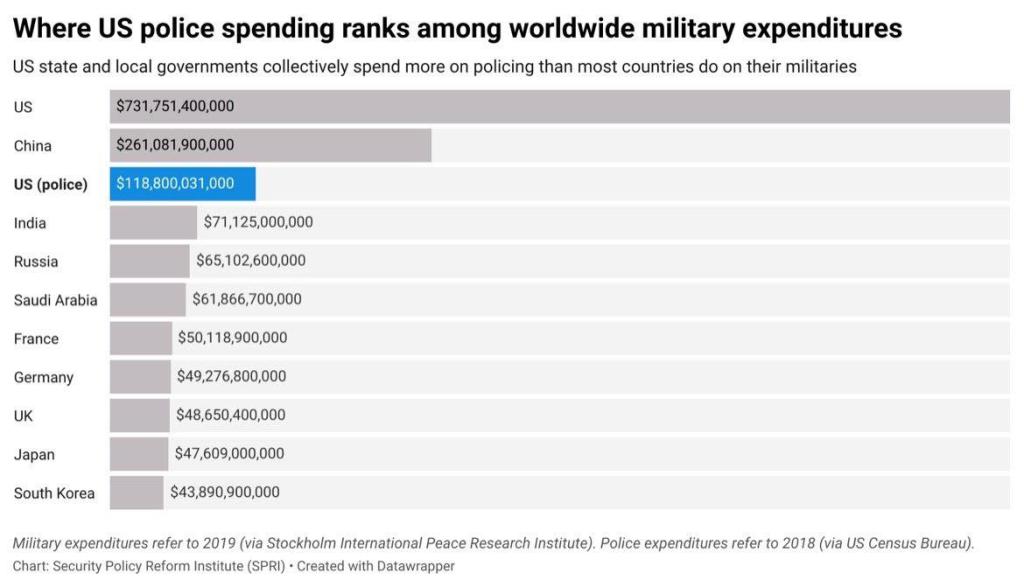
50 Trillion Dollars!
The long-term results of the redistribution of wealth are absolutely mind-boggling.
A RAND Corporation report found that $50 trillion was redistributed from bottom to top since the mid-70s. It’s hard to grasp just how profound that is and just how vicious the class struggle waged by the owning class has been. According to Time:
On average, extreme inequality is costing the median income full-time worker about $42,000 a year. Adjusted for inflation using the CPI, the numbers are even worse: half of all full time workers…now earn less than half what they would have had incomes across the distribution continued to keep pace with economic growth.
It’s the old half a loaf!

According to Business Insider: “The median college-educated American worker would have seen their annual pay double without this theft.”
This extreme exploitation is a systematic form of violence that results in suicide, premature death, and disease. It’s organized class warfare. According to a major study of life expectancy between 1959 and 2017:
“By 2014, midlife mortality was increasing across all racial groups, caused by drug overdoses, alcohol abuse, suicides, and a diverse list of organ system diseases.”
The report, cited by David Rosen in Counterpunch, continued:
“During the half-century between 1959 and 2016, Americans’ life expectancies increased by nearly 10 years. Sadly, since then, the average lifespan slowly declined….There has been an increase in death rates among working age Americans…This is an emergent crisis. And it is a uniquely American problem since it is not seen in other countries. Something about life in America is responsible.”
That exceptional “uniquely American problem” is the extreme stress of extreme poverty not experienced in other wealthy countries. This is how the ruling class maintains control here in the imperial core. Yet, there is so much hoarded treasure that $21 trillion is stashed away in tax havens around the world that allow the very richest to legally avoid taxation.
So when the bosses say “we don’t have money” you better believe they mean “we don’t have money for you!” Biden will not recover the $50 trillion heist. Why? Because the Democrat’s sorry excuses for reform avoid the main culprit: wage suppression.
The Wages of Corporate Power
Wage suppression and the attack on workers and our unions are at the heart of this epic theft. It all began with a set of structural reforms designed to break the direct link between productivity and compensation that was forged by working-class struggles during and after the Great Depression and World War II.
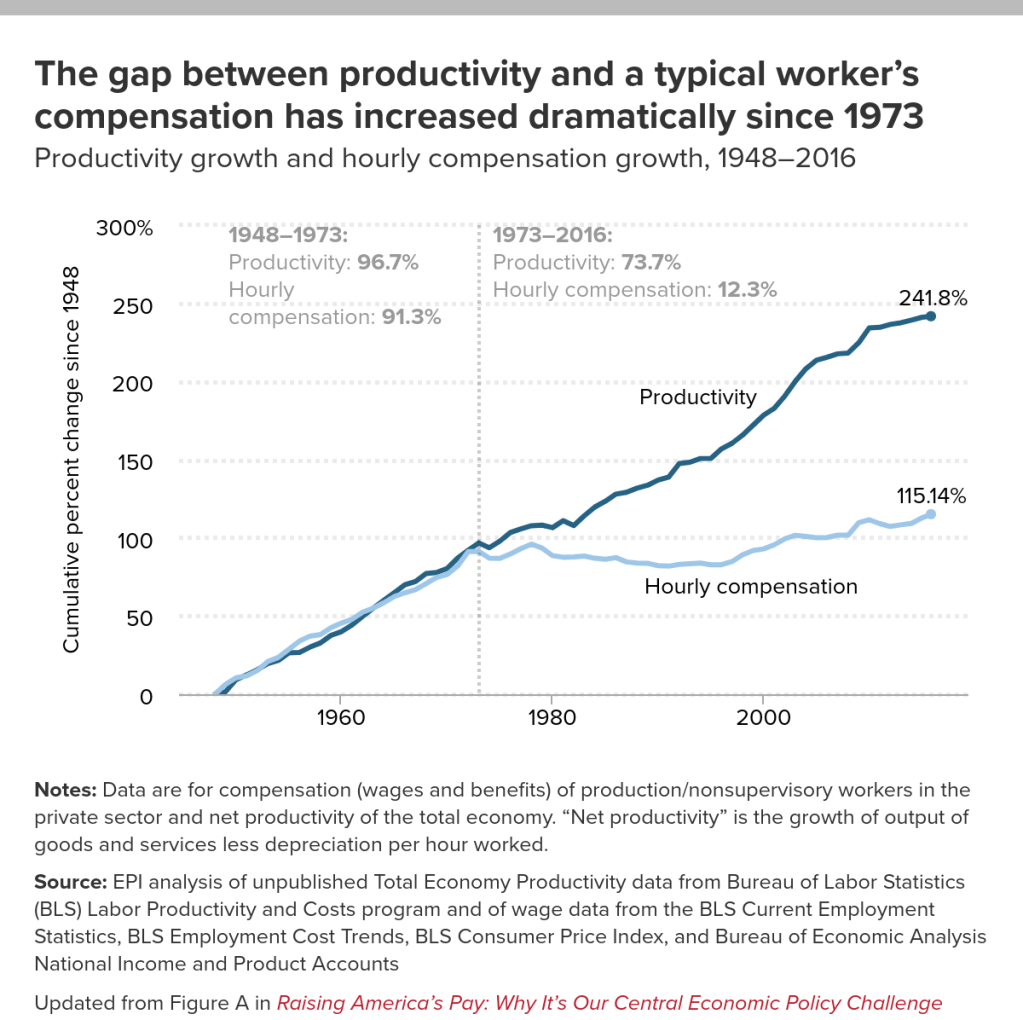
Wage suppression creates austerity. If we cannot change wages the rest is tinkering around the edges.
Take federally enforced minimum wages for example — once designed to provide a decent wage floor it now tends to pull wages down. $15 was visionary when first proposed, now it is just a new substandard minimum wage — and we can’t even get that. The failure of the Democrats to live up to that often-made promise is proof that decent wages will not be won inside the existing political order.
Both major parties are sold to the highest bidder and union officials aren’t even “at the table” despite decades of being loyal Democrats. If labor was truly “at the table,” would the Democrats have gotten away with a cheap trick like hiding behind the Parliamentarian to kill $15? This is not just an insult to every union member but a signal that beyond a few stimulus crumbs the war on the poor continues.
Not only aren’t workers “at the table” they are behind bars. The system of slave-like prison labor is a ball and chain driving down labor costs, eliminating real jobs, and weakening unions. Unions once understood this threat and fought against it. Now? Nary a word. Austerity — and the wage suppression it is founded on — will not end as long as prisoners are worked like slaves.
Now more than ever, working-class solidarity both within and outside of the formal labor movement is the best way forward. Organizing and the threat of strike, including a general strike, is infinitely more valuable than standard ways of lobbying politicians.
Since low wages lie at the heart of the austerity regime then workers are at the heart of the solution.
The Protect the Right to Organize (PRO) Act does contain many important reforms like the abolition of the “right to work” laws. The most potentially useful reforms are the legalization of spur-of-the-moment strikes; unpredictable on-again-off-again strikes; slowdowns while still at work; and “secondary” boycotts that allow unions to call boycotts against anyone they choose. All these powerful tactics were prohibited by the 1947 (and still enforced) Taft-Hartley Act — one of the first “reforms” that paved the way to austerity.
But to pass PRO, enforce PRO, and realize its promise will take an aroused and independent-minded working class. We lost the class struggle of the last four decades, in part, because we laid down our best weapon. We failed to negotiate by abandoning the class struggle in favor of collaboration with the bosses. The increase in strikes since 2018 means the fight is on again and that’s the real reason unions feel confident enough to advance national labor law reform like PRO.
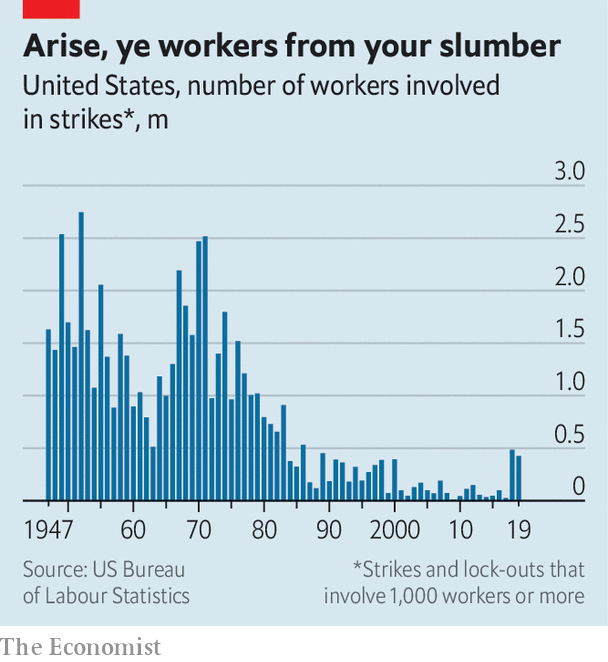
Approximately 1,300 strikes — by essential workers of all kinds, including prisoners — have occurred since the pandemic began.[2] Many strikes were self-organized, outside of official union channels.
Is this the shape of class struggles to come? Can the union movement be reborn? Only if we make it so.
1. Thomas Piketty’s Capital in the Twenty-First Century provides a wealth of evidence that the primary product of the modern corporate system is inequality. Also, see economist Richard Wolff’s The US Economy Excels in One Thing: Producing Massive Inequality in Counterpunch.
2. Follow Payday Report or join On the Picket Line for strike news.



